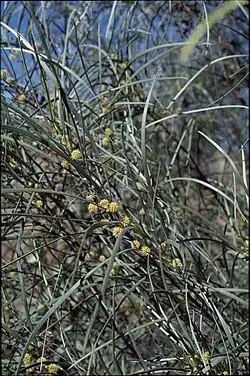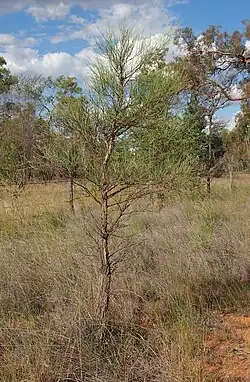Acacia coriacea
| Desert oak | |
|---|---|

| |
| Scientific classification | |
| Kingdom: | Plantae |
| Clade: | Tracheophytes |
| Clade: | Angiosperms |
| Clade: | Eudicots |
| Clade: | Rosids |
| Order: | Fabales |
| Family: | Fabaceae |
| Subfamily: | Caesalpinioideae |
| Clade: | Mimosoid clade |
| Genus: | Acacia |
| Species: | A. coriacea
|
| Binomial name | |
| Acacia coriacea | |
| Synonyms[1] | |
|
Racosperma coriaceum (DC.) Pedley | |


Acacia coriacea, commonly known as wirewood, wiry wattle or desert oak,[2] is a species of flowering plant in the family Fabaceae and is endemic to northern Western Australia. It is a spreading shrub or tree with thin bark, linear to very narrowly elliptic phyllodes, spherical heads of pale lemon yellow or cream-coloured flowers and twisted, curved or coiled pods resembling a string of beads. Indigenous Australians know the plant as Gunandru.[3]
Description
Acacia coriacea is a spreading shrub or tree that typically grows to a height of up to 10 m (33 ft) and has thin, fibrous and fissured bark, the new growth covered with silky hairs. Its phyllodes are linear to very narrowly elliptic, 90–230 mm (3.5–9.1 in) long and 1–7 mm (0.039–0.276 in) wide and leathery with many closely parallel, fine veins. The flowers are borne in one or two spherical heads on a peduncle 3–10 mm (0.12–0.39 in) long, each head with 15 to 50 pale lemon yellow to cream-coloured flowers. Flowering time depends on subspecies, and the pods are twisted, openly curved or coiled and resemble a string of beads up to 320 mm (13 in) long and 5–13 mm (0.20–0.51 in) wide and leathery. The seeds are broadly elliptic, 4–8 mm (0.16–0.31 in) long, black and glossy with a large, bright orange aril.[2][4][5][6]
Taxonomy
Acacia coriacea was first formally described in 1825 by Augustin Pyramus de Candolle in his Prodromus Systematis Naturalis Regni Vegetabilis.[7][8] In 1993, Richard Cowan and Bruce Maslin described three subspecies of A. coriacea, and the names of two subspecies are recognised by the Australian Plant Census:
- Acacia coriacea DC. subsp. coriacea[9] has mostly more or less erect, almost straight to very shallowly curved phyllodes 5–10 mm (0.20–0.39 in) wide, and flowers in June and July.[4][10]
- Acacia coriacea subsp. pendens R.S.Cowan & Maslin[11] has mostly pendulous, shallowly to strongly curved phyllodes 1.5–5 mm (0.059–0.197 in) wide, and flowers from March to August.[4][12]
A third subspecies, Acacia coriacea subsp. sericophylla (F.Muell.) R.S.Cowan & Maslin is now recognised as a synonym of Acacia sericophylla F.Muell.[13] and is found in Western Australia, the Northern Territory, South Australia, Queensland and New South Wales.
Distribution and habitat
Wirewood is widely distributed in the north of Western Australia where it grows in sand or limestone on coastal dues and ridges, sandplains and along watercourses in the Avon Wheatbelt, Carnarvon, Gascoyne, Gibson Desert, Great Sandy Desert, Pilbara, Swan Coastal Plain, Tanami and Yalgoo bioregions.[6] Subspecies coriacea has a near coastal distribution in the Avon Wheatbelt, Carnarvon, Gascoyne, Pilbara, Yalgoo bioregions[14] and subsp. pendens in the Carnarvon, Gascoyne, Pilbara and Swan Coastal Plain bioregions.[15]
Conservation status
Both subspecies of Acacia coriacea are listed as "not threatened" by the Government of Western Australia Department of Biodiversity, Conservation and Attractions.[14][15]
Uses
Indigenous Australians used the seeds of this species as a food source,[3] the wood for making spears and shields, and the ash produced from the wood was used with native tobacco (Nicotinia species) as a chewing quid.[2]
See also
References
- ^ a b "Acacia coriacea". Australian Plant Census. Retrieved 24 July 2025.
- ^ a b c Cowan, Richard S.; Maslin, Bruce R.; Reid, Jordan E. Kodela, Phillip G. (ed.). "Acacia coriacea". Flora of Australia. Australian Biological Resources Study, Department of Climate Change, Energy, the Environment and Water: Canberra. Retrieved 25 July 2025.
- ^ a b David R. Harris; Gordon C. Hillman (2014). Foraging and Farming: The Evolution of Plant Exploitation. Routledge. ISBN 9781317598299.
- ^ a b c Cowan, Richard S.; Maslin, Bruce R. (1993). "Acacia Miscellany 9. The taxonomic status of Acacia coriacea (Leguminosae: Mimosoideae: Section Plurinerves)". Nuytsia. 9 (1): 83–88. Retrieved 25 July 2025.
- ^ "Acacia coriacea". World Wide Wattle. Retrieved 25 July 2025.
- ^ a b "Acacia coriacea". FloraBase. Western Australian Government Department of Biodiversity, Conservation and Attractions.
- ^ "Acacia coriacea". APNI. Retrieved 25 July 2025.
- ^ de Candolle, Augustin P. (1825). de Candolle, Augustin P. (ed.). Prodromus systematis naturalis regni vegetabilis, sive, Enumeratio contracta ordinum generum specierumque plantarum huc usque cognitarium, juxta methodi naturalis, normas digesta. Paris: Sumptibus Sociorum Treuttel et Würtz. p. 451. Retrieved 25 July 2025.
- ^ "Acacia coriacea subsp. coriacea". Australian Plant Census. Retrieved 25 July 2025.
- ^ "Acacia coriacea DC. subsp. coriacea". Australian Botanical Resources Study. Retrieved 25 July 2025.
- ^ "Acacia coriacea subsp. pendens". Australian Plant Census. Retrieved 25 July 2025.
- ^ "Acacia coriacea DC. subsp. pendens". Australian Botanical Resources Study. Retrieved 25 July 2025.
- ^ "Acacia sericophylla". Australian Plant Census. Retrieved 25 July 2025.
- ^ a b "Acacia coriacea subsp. coriacea". FloraBase. Western Australian Government Department of Biodiversity, Conservation and Attractions.
- ^ a b "Acacia coriacea subsp. pendens". FloraBase. Western Australian Government Department of Biodiversity, Conservation and Attractions.